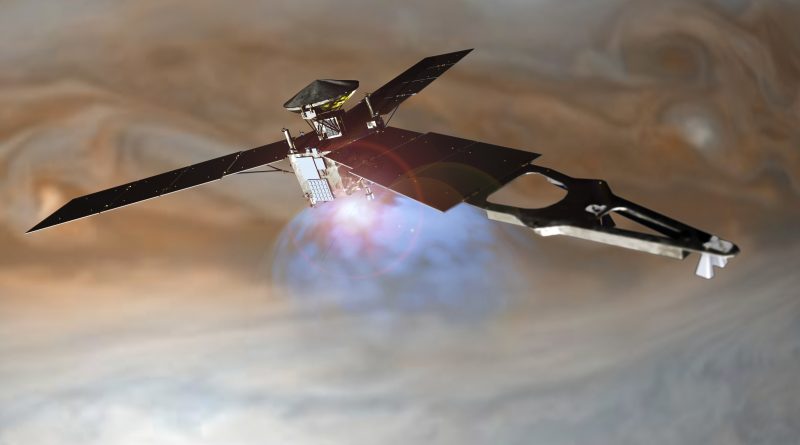Juno reaches Jupiter’s Doorstep, ready for Make-or-Break Orbit Insertion Burn
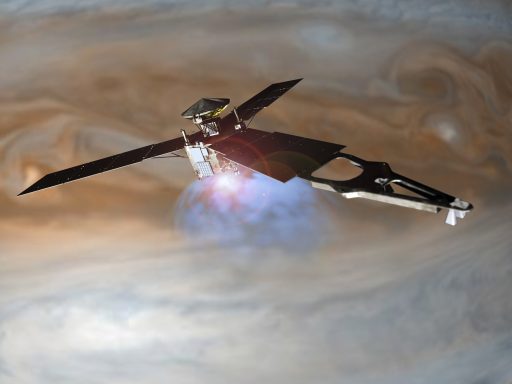
Over a decade of work and $1.1 billion are riding on NASA’s Juno spacecraft igniting its engine Monday night and placing itself into orbit around the largest planet in the solar system.
Running on autopilot, Juno is completely by itself when it ignites its main engine 868 million Kilometers from Planet Earth to begin a 20-month exploration campaign at Jupiter.
Launched in August 2011, Juno completed an odyssey of 2.8 billion Kilometers to reach its destination, swinging once around the Sun and flying by Earth to boost its speed before the long journey into the dark outer solar system, past the orbit of Mars and the Asteroid Belt to reach the King of the Gas Giants.
Since May, Jupiter has been pulling Juno in with its enormous gravitational force, accelerating the spacecraft towards the planet – expected to reach a top speed of 208,500 Kilometers per hour when zipping past the planet Monday night in a high-speed dance to slow Juno down just enough to be captured in orbit.
The four Galilean Moons are seen dancing around Jupiter in this approach video from the JunoCam instrument covering a two-day period, or one revolution of Io.
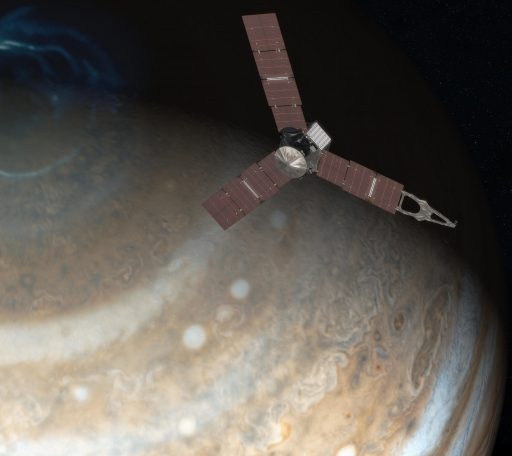
Juno’s critical main engine burn is planned to begin at 2:30 UTC, but signals confirming main engine ignition will not arrive for another 48 and a quarter minutes as the radio waves travel to Earth at the speed of light.
The mission’s operators hope to be able to confirm a successful Jupiter Orbit Insertion at 3:53 UTC.
When mission control learns of Juno’s engine ignition, Juno will already have been in orbit for 13 minutes if all went according to the plan stored in Juno’s radiation shielded computers.
The liquid-fueled engine has to fire for at least 20 minutes for Juno to enter a safe orbit around Jupiter, but the full 35-minute burn is needed to be able to fulfill the mission’s scientific objectives.
In a briefing given on Monday, the Juno mission team reported the spacecraft has been performing nominally since switching to autopilot on Thursday, executing the critical steps to get set for orbital insertion. Juno is on-course, predicted to hit the target within 1.2 seconds of what was expected prior to the craft’s launch on its five-year voyage.
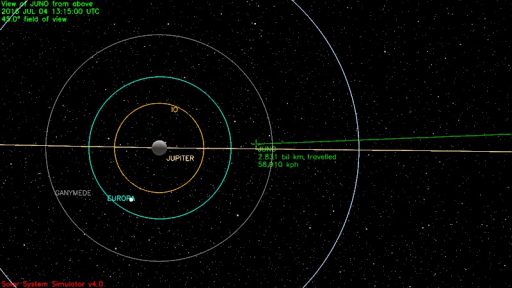
The biggest unknown in Monday’s night’s JOI maneuver is Jupiter’s intense radiation.
Satellites in orbit around Earth use radiation-hardened systems to avoid upsets of their electronics, but near Jupiter, the radiation environment is an order of magnitude tougher, requiring Juno’s designers to go through great lengths to protect the spacecraft’s computers and electronics. Juno features a 200-Kilogram titanium vault to shield all the important controllers and electronics, though even the thick vault will not eliminate all radiation and occasional upsets are possible if Juno is hit by high-energy particles.
Should Juno encounter a radiation-related upset during JOI, the spacecraft is programmed to automatically reboot its computer and re-start the engine within 500 seconds of the upset.
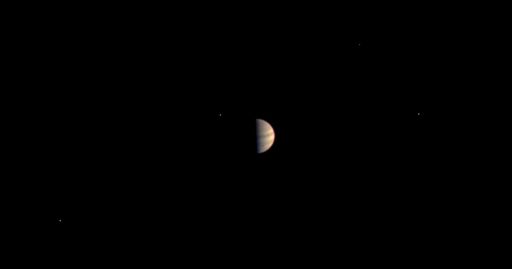
Juno’s Orbital Insertion Timeline begins at 1:13 UTC Earth Receive Time (ERT) with the switch of communications from the High to the Medium Gain Antenna to prepare for the attitude maneuver to the correct burn orientation. At the same time, the spacecraft begins sending tones – a very basic form of communications in which the vehicle transmits ten-second long signals at specific frequencies.
A library of 256 tones is available to Juno comprised of heartbeat tones that signal the spacecraft is still alive and doing okay, tones for specific mission events, and tones corresponding to specific spacecraft statuses – allowing some insight into the progress of Juno’s critical sequence even when all directional antennas are pointed away from Earth.
Five antennas at the Goldstone Deep Space Network Station in California are tasked with receiving signals from Juno with four antennas at the Canberra Station in Australia available as backup, also recording all signals from the faraway spacecraft.
>>Juno Mission & Trajectory Design
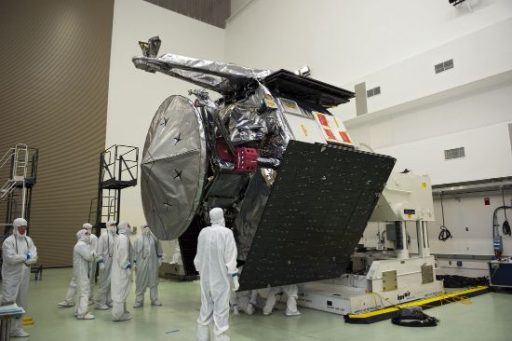
At 1:16 UTC, Juno initiates a slow re-orientation, slewing to a 15-degree sun angle to set up for a larger re-orientation closer to the JOI maneuver. With Juno pointing further away from Earth, communications will be switched to the hemispherical low gain antenna.
Teams on the ground will be tracking the night’s events via tones and by analyzing the Doppler Shift of Juno’s carrier signal that will provide a very precise means of tracking the actual velocity change achieved with the burn.
At 2:28 UTC, Juno initiates the re-orientation for the JOI attitude, facing its main engine toward the direction of travel – a 15-minute maneuver. Active nutation dampening – nulling out any residual body rates from the attitude maneuver – begins at 2:45 UTC, followed five minutes later by a fine adjustment of Juno’s orientation.
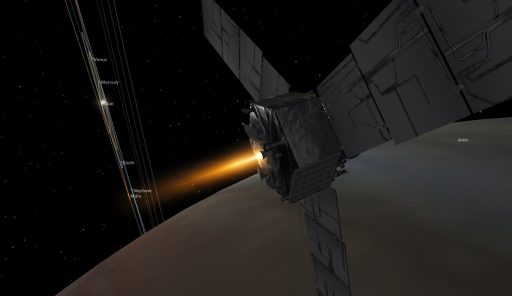
Juno has been spin-stabilized throughout its long journey through the solar system, making 2 revolutions per minute during the cruise phases of the flight and increasing its RPM to five for main engine maneuvers. Spin-up begins at 2:56 and is the last critical event prior to main engine ignition at 3:18.
Juno’s main engine is a Leros 1b hypergolic rocket engine consuming Monomethylhydrazine fuel and Mixed Oxides of Nitrogen as oxidizer – a mixture that self-ignites when the two components come into contact. Ignition is accomplished by opening propellant valves to the engine chamber and propellants are fed to the engine by tank pressurization using Helium gas.
Built in the UK, Leros 1b has flown on over 70 Geostationary Satellites and NASA missions to Mercury and Mars. During the Juno mission, the engine has proven itself during a pair of Deep Space Maneuvers in 2012, firing for 29.5 and 30 minutes, though Monday night’s burn will be its longest during the mission.
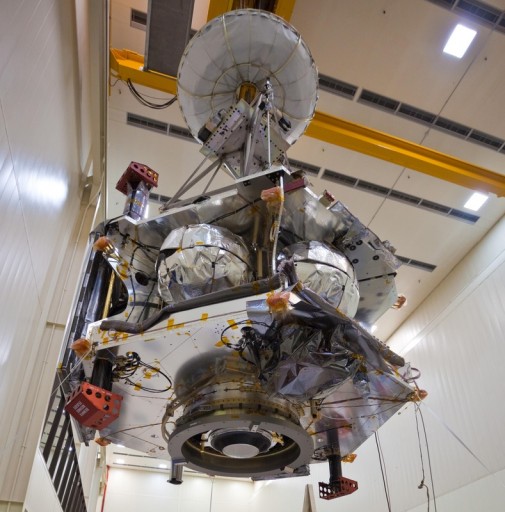
Delivering 65.8 Kilogram-force of thrust, Leros 1b is tasked with slowing the spacecraft down by 541.7 meters per second, in the process consuming 785 Kilograms of propellant.
The burn has to hit the mark perfectly to enable Juno to complete its mission of discovery. Burning too long would put Juno into an orbit too close to Jupiter, a premature cutoff would result into Juno flying past the planet and entering a solar orbit, never to return to its planned destination.
Juno uses a number of systems to watch over its burn, most notably its accelerometers that tell the spacecraft very precisely how much it has slowed down – engine cutoff will be triggered once Juno determines it reached the planned delta-v. Juno also monitors the engine mixture ratio to assess whether an under- or overperformance of the engine is occurring to dynamically adjust the burn. Finally, a timer ensures the burn can not run too long.
One more unknown for Juno is Jupiter’s dust environment as the extent of the planet’s rings is not well understood, posing a danger when flying the spacecraft in an engines-first configuration. A dust impact onto the engine nozzle could cause lethal damage to the powerplant and spoil 12 years of work by the mission’s team.
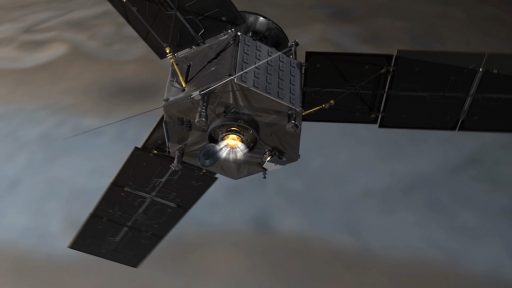
Juno’s closest approach to Jupiter occurs at 3:35:50 UTC (ERT) with an expected altitude less than 4,700 Kilometers above Jupiter’s cloud tops – the closest any spacecraft has ever come to the gas giant. It is this time the team expects the highest risk of a dust particle impact based on models of Jupiter’s rings.
When the burn is complete, Juno will swiftly spin down and re-orient to point its solar arrays back at the sun after spending 103 minutes in an off-sun attitude, relying on its batteries to power the spacecraft.
Juno has already set the record for the most distant spacecraft purely powered by solar power, requiring three very large solar arrays to generate 500 Watts of power at Jupiter where sunlight is 25 times less intense than it is near Earth.
Because of the mission’s power constraints, the turn back to the sun is crucial for Juno’s survival past Jupiter Orbit Insertion. For Scott Bolton, the mission’s Principal Investigator, the nail-biting will only stop when Juno is pointing back at the sun and generating power.
Medium Gain communications will resume at 4:11 UTC and Juno will begin delivering telemetry five minutes later, though it may take well over 20 minutes to establish a good telemetry lock.
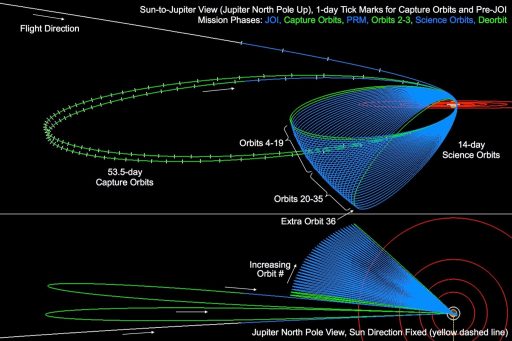
Juno’s JOI Sequence formally concludes at 5:48 UTC when the mission heads into its Capture Orbit Phase, making two laps around Jupiter in 107 days, 53.5 days per orbit with one low pass on August 27 that will be a full rehearsal of science operations that take place centered around Juno’s perijove passes.
Juno’s instruments were shut down last week to reduce risk to the critical JOI maneuver, eliminating the possibility of an instrument-related hiccup causing a spacecraft safe mode. They could be turned on again as soon as Thursday morning (UTC) should everything work out as planned Monday night to set up for final testing and rehearsals of regular mission operations.
Looking further ahead, Juno will fire up its main engine again on October 19 to reduce its orbital period to 14 days, setting up for the mission’s 33 science orbits. Juno’s mission will last until February 2018, dedicated to unlocking Jupiter’s secrets by peering through its dense cloud covers, but before that precious science data can arrive on Earth, Juno has to thread the needle Monday night and become only the second spacecraft to enter orbit around Jupiter.

